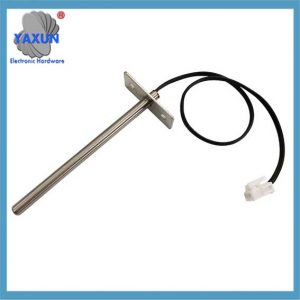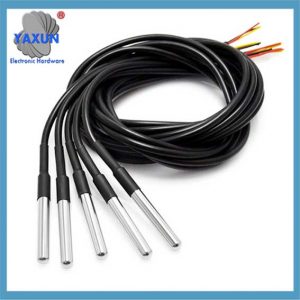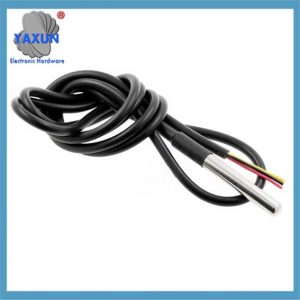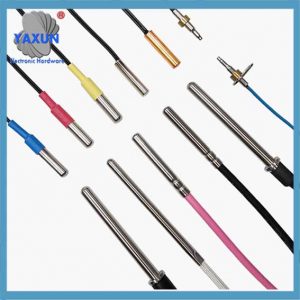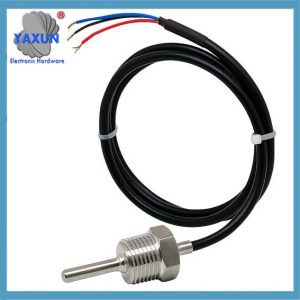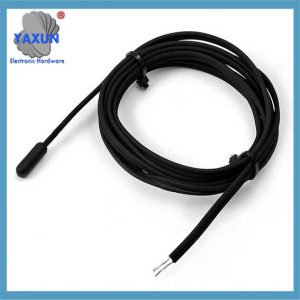在现代传感技术中的应用, (NTC, 正温度系数, PT100, 热电偶, 热电阻, DS18B20, ETC. 电缆, 探针套件) 温度传感器是关键的测量工具. 它们广泛应用于工业自动化, 农业监测, 汽车制造等领域. 为了保证温度传感器在潮湿或潮湿的环境下能够稳定可靠地工作, 防水和防水技术已成为重要的设计点. 以下是温度传感器的防水和防潮的几个技术点:
1. 包装设计
包装材料: 防水和防水温度传感器通常使用高性能包装材料. 这些材料具有出色的防水和防湿特性. 常见的包装材料包括耐腐蚀金属 (例如不锈钢) 和工程塑料 (例如聚二氟乙烯). 它们可以有效地隔离水分和液体,并保护内部电子组件免受损害.
密封技术: 为了增强防水性能, 密封技术,例如O形圈, 包装中使用了硅胶密封环或环氧树脂盆栽. 这些密封措施可以防止水和水分通过接缝或开口进入传感器, 从而改善其环境适应性.
2. 防护等级
IP级别: 温度传感器的防水和防水性能通常由IP表示 (入学保护) 等级. IP级别由两个数字组成, 第一个数字表示针对固体物质的保护水平, 第二个数字表示针对液体的保护水平. 例如, IP67意味着传感器完全防尘,并且可以正常工作 30 沉浸分钟 1 米的水.
耐腐蚀的涂层: 在某些特别严峻的环境中, 例如化学植物, 传感器可能会暴露于腐蚀性物质中. 为此原因, 可以将耐腐蚀涂层应用于传感器的表面,以进一步增强其保护.
3. 材料选择
耐腐蚀的材料: 为了应对潮湿环境中可能的腐蚀问题, 传感器通常由耐腐蚀材料制成. 例如, 不锈钢 (例如 304 或316L不锈钢) 具有极好的耐腐蚀性,适合在湿和酸碱环境中使用.
绝缘材料: 内部电子组件的绝缘材料也必须具有极高的耐水性. 高质量的绝缘材料可以防止水分渗透到传感器的电路中, 从而避免短路或损坏.
4. 结构设计
排气孔设计: 为了防止因温度变化引起的内部气压变化而破坏包装, 防水和防水温度传感器通常用通风孔设计. 这些通风孔使用微孔膜或透气材料,使内部气体自由排放,而不允许水分和灰尘进入.
固定结构: 传感器的连接部分和固定结构设计还需要考虑防水和防水因素. 通过合理的固定和修复方法, 阻止水分通过连接点进入传感器.
5. 测试和认证
环境测试: 为了确保传感器的防水和防水性能, 通常需要严格的环境测试. 这些测试包括沉浸测试, 高湿度环境测试, 和温度变化测试,以确保传感器在各种恶劣的环境条件下可以稳定工作.
认证标准: 传感器的防水性能和防水性能经常根据国际标准进行认证, 例如ISO 20653 或IEC 60529. 这些认证标准为保护水平和测试方法提供了详细的要求,以帮助确保产品满足保护性能的要求.
概括
温度传感器的防水和防水技术是确保其在复杂环境中稳定操作的关键. 通过优化包装设计, 选择正确的材料, 改善结构设计并进行严格的测试和认证, 传感器的环境适应性可以有效提高. 这些技术要点不仅提高了传感器的耐用性, 但还要确保其在各种潮湿或潮湿环境中的可靠性和准确性.
 English
English العربية
العربية Български
Български 粤语
粤语 中文(简体)
中文(简体) 中文(漢字)
中文(漢字) Nederlands
Nederlands Suomi
Suomi Français
Français Deutsch
Deutsch Ελληνικά
Ελληνικά Magyar
Magyar Italiano
Italiano 日本語
日本語 한국어
한국어 Polski
Polski Português
Português Română
Română Русский
Русский Slovenščina
Slovenščina Español
Español Svenska
Svenska ภาษาไทย
ภาษาไทย Türkçe
Türkçe Tiếng Việt
Tiếng Việt
